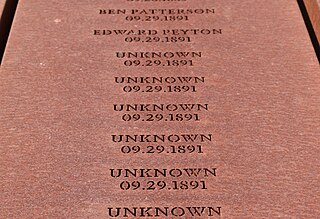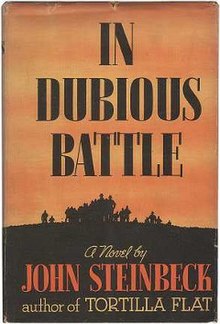
John Ernst Steinbeck was an American writer. He won the 1962 Nobel Prize in Literature "for his realistic and imaginative writings, combining as they do sympathetic humor and keen social perception". He has been called "a giant of American letters."

The Grapes of Wrath is an American realist novel written by John Steinbeck and published in 1939. The book won the National Book Award and Pulitzer Prize for fiction, and it was cited prominently when Steinbeck was awarded the Nobel Prize in Literature in 1962.

The United Farm Workers of America, or more commonly just United Farm Workers (UFW), is a labor union for farmworkers in the United States. It originated from the merger of two workers' rights organizations, the National Farm Workers Association (NFWA) led by César Chávez, Dolores Huerta, and Gilbert Padilla and the Agricultural Workers Organizing Committee (AWOC) led by organizer Larry Itliong. They allied and transformed from workers' rights organizations into a union as a result of a series of strikes in 1965, when the Filipino-American and Mexican-American farmworkers of the AWOC in Delano, California, initiated a grape strike, and the NFWA went on strike in support. As a result of the commonality in goals and methods, the NFWA and the AWOC formed the United Farm Workers Organizing Committee on August 22, 1966. This organization was accepted into the AFL–CIO in 1972 and changed its name to the United Farm Workers Union.

The Women's Trade Union League (WTUL) (1903–1950) was a U.S. organization of both working class and more well-off women to support the efforts of women to organize labor unions and to eliminate sweatshop conditions. The WTUL played an important role in supporting the massive strikes in the first two decades of the twentieth century that established the International Ladies' Garment Workers' Union and Amalgamated Clothing Workers of America and in campaigning for women's suffrage among men and women workers.
On April 21, 1920, during a miners strike in Butte, Montana's copper mines, company guards fired on striking miners picketing near a mine of the Anaconda Copper Mining Company, killing Tom Manning and injuring sixteen others, an event known as the Anaconda Road massacre. His death went unpunished.
The Toledo Auto-Lite strike was a strike by a federal labor union of the American Federation of Labor (AFL) against the Electric Auto-Lite company of Toledo, Ohio, from April 12 to June 3, 1934.
Samuel Pollock was an American labor union activist and leader. He helped lead two important strikes in 1934, the Auto-Lite Strike and the Hardin County onion pickers strike, before becoming district president of the Amalgamated Meat Cutters and Butcher Workmen of North America.

The Hardin County onion pickers strike was a strike by agricultural workers in Hardin County, Ohio, in 1934. Led by the Agricultural Workers Union, Local 19724, the strike began on June 20, two days after the trade union formed. After the kidnapping and beating of the union's leader and the intervention of the Ohio National Guard on behalf of the growers, the strike ended in October with a partial victory for the union. Some growers met the union's demand for a 35-cents-an-hour minimum wage, but the majority did not.

The Salad Bowl strike was a series of strikes, mass pickets, boycotts and secondary boycotts that began on August 23, 1970 and led to the largest farm worker strike in U.S. history. The strike was led by the United Farm Workers against the International Brotherhood of Teamsters. The Salad Bowl strike was only in part a jurisdictional strike, for many of the actions taken during the event were not strikes. The strike led directly to the passage of the California Agricultural Labor Relations Act in 1975.
The Stockton cannery strike of 1937, also known as the spinach riot, was the bloody culmination of conflict between the Agricultural Workers Organization local and the California Processors and Growers in the San Joaquin Valley of California. The riots of April 23, 1937, in which both sides were armed with clubs and firearms, began in front of a Stockton cannery and resulted in one death, over fifty serious injuries and tied up the movement of a $6 million vegetable crop. The strike is remembered as the most violent confrontation in a long struggle between unions and growers for control of Stockton canneries and the political, economic and labor ramifications that affected California for years to come.

The California agricultural strikes of 1933 were a series of strikes by mostly Mexican and Filipino agricultural workers throughout the San Joaquin Valley. More than 47,500 workers were involved in the wave of approximately 30 strikes from 1931 to 1941. Twenty-four of the strikes, involving 37,500 union members, were led by the Cannery and Agricultural Workers' Industrial Union (CAWIU). The strikes are grouped together because most of them were organized by the CAWIU. Strike actions began in August among cherry, grape, peach, pear, sugar beet, and tomato workers, and culminated in a number of strikes against cotton growers in the San Joaquin Valley in October. The cotton strikes involved the largest number of workers. Sources vary as to numbers involved in the cotton strikes, with some sources claiming 18,000 workers and others just 12,000 workers, 80% of whom were Mexican.

The Congress of Industrial Organizations (CIO) was a federation of unions that organized workers in industrial unions in the United States and Canada from 1935 to 1955. Originally created in 1935 as a committee within the American Federation of Labor (AFL) by John L. Lewis, a leader of the United Mine Workers (UMW), and called the Committee for Industrial Organization. Its name was changed in 1938 when it broke away from the AFL. It focused on organizing unskilled workers, who had been ignored by most of the AFL unions.

The Harvest Gypsies, by John Steinbeck, is a series of feature-story articles written on commission for The San Francisco News about the lives and times of migrant workers in California's Central Valley. Published daily from October 5 to 12, 1936, Steinbeck explores and explains the hardships and triumphs of American migrant workers during the Great Depression, tracing their paths and the stories of their lives and travels from one crop harvest to the next crop harvest as they eked out a stark existence as temporary farmhands.

In Dubious Battle is a 2016 drama film directed and produced by James Franco, loosely based on John Steinbeck's 1936 novel of the same name, with a screenplay by Matt Rager. The film features an ensemble cast, consisting of Franco, Nat Wolff, Josh Hutcherson, Vincent D'Onofrio, Robert Duvall, Selena Gomez, Keegan Allen and Ed Harris. The film had its world premiere at the Venice Film Festival on September 3, 2016.

In 1933 there was a cherry strike in Santa Clara, California. The main overview of the events in Santa Clara was an agricultural strike by cherry pickers against the growers or employers. As the events of the labor strike unfolded, the significance of the strike grew beyond that of the workers themselves into a broader scope within America.
The 1933 Yakima Valley strike took place on 24 August 1933 in the Yakima Valley, Washington, United States. It is notable as the most serious and highly publicized agricultural labor disturbance in Washington history and as a brief revitalization of the Industrial Workers of the World in the region.

The cotton pickers' strike of 1891 was a labor action of African-American sharecroppers in Lee County, Arkansas in September, 1891. The strike led to open conflict between strikers and plantation owners, racially-motivated violence, and both a sheriff's posse and a lynching party. One plantation manager, two non-striking workers, and some twelve strikers were killed during the incident. Nine of those strikers were hung in a mass lynching on the evening of September 29.
Pat Chambers was an influential labor organizer and Communist Party member in the 1930s in California. He was a key figure in some of the largest California agricultural strikes of 1933. Chambers was the inspiration for the character "Mac" in John Steinbeck's 1936 novel, In Dubious Battle.
The Associated Farmers of California was an influential anti-labor organization in California between 1934 and 1939. Agricultural and business leaders formed the organization to counter growing labor activism in California. The AF was responsible for substantial violence in reaction to agricultural strikes; the creation of anti-picketing ordinances; and spying on the activities of labor organizations. After a US Senate investigation into its actions and the advent of WW2, it lost influence and eventually disbanded. “The reign of the AF would only come to an end when the LaFollette Committee turned its scrutiny towards its activities in 1939 and 1940." The committee's attention short-circuited the AF's attempt to expand across the United States.”
“The Raid” is a work of short fiction by John Steinbeck originally published in The North American Review, October 1934. The story was first collected in The Long Valley (1938) by Viking Press.












